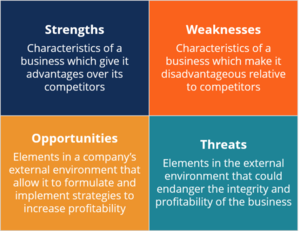SWOT Analysis
A SWOT Analysis is a high-level strategic planning model that helps organizations identify where they’re doing well and where they can improve, both from an internal and external perspective. It is an acronym for “Strengths, Weaknesses, Opportunities, and Threats.”[1]

source: CFI
Characteristics of a SWOT Analysis[2]
A SWOT analysis focuses on the four elements of the acronym, allowing companies to identify the forces influencing a strategy, action or initiative. Knowing these positive and negative elements can help companies more effectively communicate what parts of a plan need to be recognized.
When drafting a SWOT analysis, individuals typically create a table split into four columns to list each impacting element side by side for comparison. Strengths and weaknesses won't typically match listed opportunities and threats verbatim, although they should correlate since they are ultimately tied together.
Billy Bauer, managing director of Royce Leather, noted that pairing external threats with internal weaknesses can highlight the most serious issues a company faces.
"Once you've identified your risks, you can then decide whether it is most appropriate to eliminate the internal weakness by assigning company resources to fix the problems, or to reduce the external threat by abandoning the threatened area of business and meeting it after strengthening your business," said Bauer.
Internal factors
Strengths (S) and weaknesses (W) refer to internal factors, which are the resources and experience readily available to you.
These are some commonly considered internal factors:
- Financial resources (funding, sources of income, and investment opportunities)
- Human resources (employees, volunteers, and target audiences)
- Access to natural resources, trademarks, patents, and copyrights
- Current processes (employee programs, department hierarchies, and software systems)
External factors
External forces influence and affect every company, organization, and individual. Whether these factors are connected directly or indirectly to an opportunity (O) or threat (T), it is important to note and document each one.
External factors are typically things you or your company do not control, such as the following:
- Market trends (new products, technology advancements, and shifts in audience needs)
- Economic trends (local, national and international financial trends)
- Funding (donations, legislature, and other sources)
- Demographics
- Relationships with suppliers and partners
- Political, environmental and economic regulations
After you create your SWOT framework and fill out your SWOT analysis, you will need to come up with some recommendations and strategies based on the results. Linda Pophal, owner and CEO of consulting firm Strategic Communications, said these strategies should focus on leveraging strengths and opportunities to overcome weaknesses and threats.
"This is actually the area of strategy development where organizations have an opportunity to be most creative and where innovative ideas can emerge, but only if the analysis has been appropriately prepared in the first place," said Pophal.
See Also
